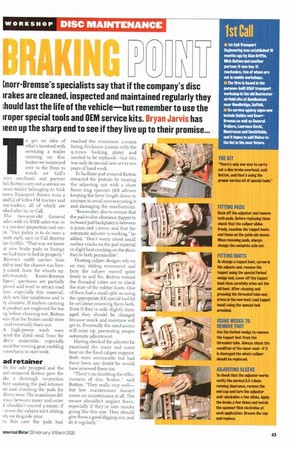RAM,:
Page 43

If you've noticed an error in this article please click here to report it so we can fix it.
(norr-Bremse's specialists say that if the company's disc !rakes are cleaned, inspected and maintained regularly they ;hould last the life of the vehicle—but remember to use the iroper special tools and OEM service kits. Bryan Jarvis has leen up the sharp end to see if they live up to their promise...
0 get an idea of what's involved with servicing a trailer running on disc brakes we journeyed over to the Fens to watch ist Call's !nior mechanic and partner lick Button carry out a service on semi-trailer belonging to Nick rown Transport. Brown runs a mdful of Volvo FM tractors and mi-trailers, all of which are oked after by 1st Call.
The two-year-old General .ailer with its SMB axles was in r a pre-test inspection and serce. "Our policy is to do ours a onth early, says hit Call director Ian Griffin. "That way we know at new brake pads or linings we had time to bed in properly." Brown's outfit carries lime sidue and the chassis was liter* caked, from the wheels up.
nfortunately Knorr-Bremse lipers' apertures are partially posed and tend to attract road ime. especially this material, -all sets like sandstone and is ry abrasive. If trailers carrying is product are neglected for too ng before cleaning out. Button ini.s that the brakes could seize and eventually burn out.
A high-power wash soon !ared the dried mud from the Liles underside, especially )und the running gear, enabling mechanic to start work.
ad retainer
Lth the axle propped and the tech removed Button gave the Ike a thorough inspection fore undoing the pad retainer ite and checking the pads for iform wear. The maximum dif.ence bebx een inner and outer d shouldn't exceed 3.0mm; if ; more the caliper isn't sliding ely on its guide pins.
In this case the pads had reached the minimum 2.omm lining thickness (iImm with the 9.omm backing plate) and needed to be replaced—but this was only its second new set in two years of hard work.
To facilitate pad removal Button retracted the pistons by turning the adjusting nut with a short 8mm ring spanner (KB advises keeping the lever length down to loomm to avoid over-torqueing it and damaging the mechanism).
"Remember also to ensure that the pad-to-disc clearance (tappet to in-board pad backplate) is between o.5mm and 1. °min and that the automatic adjuster is working," he added. "Don't worry about small surface cracks on the pad material or slight heat cracking on the discs; they're both permissible".
Floating caliper designs rely on an easy sliding movement and here the caliper moved quite freely to and fro. Button wound the threaded tubes out to check the state of the rubber boots. One of them had a small split, so using the appropriate KB special tool kit he set about renewing them both. Even if they're only slightly damaged they should be changed because muck and moisture will get in. Eventually the mechanism will seize up. preventing proper automatic adjustment.
Having checked the adjuster he examined the inner and outer boot on the fixed caliper support. Both were serviceable but had there been any doubt he would have renewed them too.
"There's no doubting the effectiveness of disc brakes," said Button. "They really stop well— but low maintenance doesn't mean no maintenance at all. The owner shouldn't neglect them, especially if they're into mucky going like this one. They should give them a good digging out, and do it regularly."












































































































































